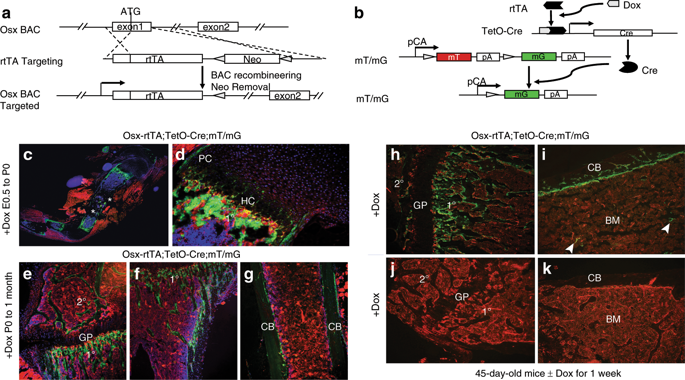Our official English website, www.x-mol.net, welcomes your
feedback! (Note: you will need to create a separate account there.)
Inducible expression of Wnt7b promotes bone formation in aged mice and enhances fracture healing.
Bone Research ( IF 14.3 ) Pub Date : 2020-02-03 , DOI: 10.1038/s41413-019-0081-8 Deye Song 1, 2 , Guangxu He 1, 2 , Fangfang Song 3 , Zhepeng Wang 2 , Xiaochen Liu 2 , Lele Liao 1 , Jiangdong Ni 1 , Matthew J Silva 2 , Fanxin Long 2, 3
Bone Research ( IF 14.3 ) Pub Date : 2020-02-03 , DOI: 10.1038/s41413-019-0081-8 Deye Song 1, 2 , Guangxu He 1, 2 , Fangfang Song 3 , Zhepeng Wang 2 , Xiaochen Liu 2 , Lele Liao 1 , Jiangdong Ni 1 , Matthew J Silva 2 , Fanxin Long 2, 3
Affiliation

|
There remain unmet clinical needs for safe and effective bone anabolic therapies to treat aging-related osteoporosis and to improve fracture healing in cases of nonunion or delayed union. Wnt signaling has emerged as a promising target pathway for developing novel bone anabolic drugs. Although neutralizing antibodies against the Wnt antagonist sclerostin have been tested, Wnt ligands themselves have not been fully explored as a potential therapy. Previous work has demonstrated Wnt7b as an endogenous ligand upregulated during osteoblast differentiation, and that Wnt7b overexpression potently stimulates bone accrual in the mouse. The earlier studies however did not address whether Wnt7b could promote bone formation when specifically applied to aged or fractured bones. Here we have developed a doxycycline-inducible strategy where Wnt7b is temporally induced in the bones of aged mice or during fracture healing. We report that forced expression of Wnt7b for 1 month starting at 15 months of age greatly stimulated trabecular and endosteal bone formation, resulting in a marked increase in bone mass. We further tested the effect of Wnt7b on bone healing in a murine closed femur fracture model. Induced expression of Wnt7b at the onset of fracture did not affect the initial cartilage formation but promoted mineralization of the subsequent bone callus. Thus, targeted delivery of Wnt7b to aged bones or fracture sites may be explored as a potential therapy.
中文翻译:

Wnt7b的诱导表达促进衰老小鼠的骨形成并增强骨折愈合。
对于安全有效的骨合成代谢疗法,以治疗与衰老相关的骨质疏松症并改善不愈合或延迟愈合的骨折愈合,临床上仍存在未满足的需求。Wnt信号已成为开发新型骨合成代谢药物的有希望的目标途径。尽管已经测试了针对Wnt拮抗剂硬化蛋白的中和抗体,但Wnt配体本身尚未被充分探索为潜在疗法。先前的研究表明,Wnt7b是成骨细胞分化过程中上调的内源性配体,并且Wnt7b的过表达有效刺激了小鼠的骨增生。但是,较早的研究并未解决Wnt7b在专门用于老化或骨折的骨骼时是否能促进骨骼形成。在这里,我们开发了一种强力霉素诱导的策略,其中Wnt7b在老年小鼠的骨骼中或在骨折愈合过程中暂时诱导。我们报道,从15个月大开始强迫表达Wnt7b 1个月极大地刺激了小梁和骨内膜骨形成,导致骨量显着增加。我们进一步在小鼠闭合性股骨骨折模型中测试了Wnt7b对骨愈合的影响。骨折开始时Wnt7b的诱导表达不影响最初的软骨形成,但促进了随后骨call的矿化。因此,可以探索将Wnt7b靶向递送至老化的骨骼或骨折部位作为潜在的治疗方法。我们报道,从15个月大开始强迫表达Wnt7b 1个月极大地刺激了小梁和骨内膜骨形成,导致骨量显着增加。我们进一步在小鼠闭合性股骨骨折模型中测试了Wnt7b对骨愈合的影响。骨折开始时Wnt7b的诱导表达不影响最初的软骨形成,但促进了随后骨call的矿化。因此,可以将Wnt7b靶向递送至老化的骨骼或骨折部位作为潜在的治疗方法。我们报道,从15个月大开始强迫表达Wnt7b 1个月极大地刺激了小梁和骨内膜骨形成,导致骨量显着增加。我们进一步在小鼠闭合性股骨骨折模型中测试了Wnt7b对骨愈合的影响。骨折开始时Wnt7b的诱导表达不影响最初的软骨形成,但促进了随后骨call的矿化。因此,可以将Wnt7b靶向递送至老化的骨骼或骨折部位作为潜在的治疗方法。骨折开始时Wnt7b的诱导表达不影响最初的软骨形成,但促进了随后骨call的矿化。因此,可以将Wnt7b靶向递送至老化的骨骼或骨折部位作为潜在的治疗方法。骨折开始时Wnt7b的诱导表达不影响最初的软骨形成,但促进了随后骨call的矿化。因此,可以将Wnt7b靶向递送至老化的骨骼或骨折部位作为潜在的治疗方法。
更新日期:2020-02-03
中文翻译:

Wnt7b的诱导表达促进衰老小鼠的骨形成并增强骨折愈合。
对于安全有效的骨合成代谢疗法,以治疗与衰老相关的骨质疏松症并改善不愈合或延迟愈合的骨折愈合,临床上仍存在未满足的需求。Wnt信号已成为开发新型骨合成代谢药物的有希望的目标途径。尽管已经测试了针对Wnt拮抗剂硬化蛋白的中和抗体,但Wnt配体本身尚未被充分探索为潜在疗法。先前的研究表明,Wnt7b是成骨细胞分化过程中上调的内源性配体,并且Wnt7b的过表达有效刺激了小鼠的骨增生。但是,较早的研究并未解决Wnt7b在专门用于老化或骨折的骨骼时是否能促进骨骼形成。在这里,我们开发了一种强力霉素诱导的策略,其中Wnt7b在老年小鼠的骨骼中或在骨折愈合过程中暂时诱导。我们报道,从15个月大开始强迫表达Wnt7b 1个月极大地刺激了小梁和骨内膜骨形成,导致骨量显着增加。我们进一步在小鼠闭合性股骨骨折模型中测试了Wnt7b对骨愈合的影响。骨折开始时Wnt7b的诱导表达不影响最初的软骨形成,但促进了随后骨call的矿化。因此,可以探索将Wnt7b靶向递送至老化的骨骼或骨折部位作为潜在的治疗方法。我们报道,从15个月大开始强迫表达Wnt7b 1个月极大地刺激了小梁和骨内膜骨形成,导致骨量显着增加。我们进一步在小鼠闭合性股骨骨折模型中测试了Wnt7b对骨愈合的影响。骨折开始时Wnt7b的诱导表达不影响最初的软骨形成,但促进了随后骨call的矿化。因此,可以将Wnt7b靶向递送至老化的骨骼或骨折部位作为潜在的治疗方法。我们报道,从15个月大开始强迫表达Wnt7b 1个月极大地刺激了小梁和骨内膜骨形成,导致骨量显着增加。我们进一步在小鼠闭合性股骨骨折模型中测试了Wnt7b对骨愈合的影响。骨折开始时Wnt7b的诱导表达不影响最初的软骨形成,但促进了随后骨call的矿化。因此,可以将Wnt7b靶向递送至老化的骨骼或骨折部位作为潜在的治疗方法。骨折开始时Wnt7b的诱导表达不影响最初的软骨形成,但促进了随后骨call的矿化。因此,可以将Wnt7b靶向递送至老化的骨骼或骨折部位作为潜在的治疗方法。骨折开始时Wnt7b的诱导表达不影响最初的软骨形成,但促进了随后骨call的矿化。因此,可以将Wnt7b靶向递送至老化的骨骼或骨折部位作为潜在的治疗方法。










































 京公网安备 11010802027423号
京公网安备 11010802027423号